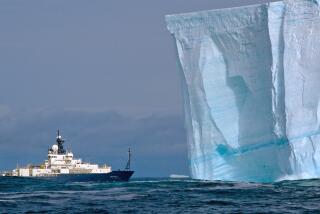Going With the Floe
- Share via
The tongue of ice, all blue and white, lashed out of the alpine valley on the west coast of New Zealand’s South Island. It lapped over ground-up boulders and the stumps of ravaged trees.
This was Franz Josef Glacier, a massive tumble of snow and ice that sweeps down from the jagged crests near Mt. Cook to the tree ferns and orchids of a rain forest by the Tasman Sea.
“Franz Josef is much the best,” said Rahni, our sturdy Maori guide, kicking a chunk of gravel from his boot sole. “Most glaciers are way up there. They terminate at 6,000 feet. This one, she comes down to 500 feet.”
He doffed his hat to the river of ice, whose swath is as straight as a ski jump.
Compared to neighboring Fox Glacier, which curves into hiding midway down, the bold view of Franz Josef is uninterrupted for more than five miles. The tip of its tongue is 400 feet thick, as high as a 40-story building. Yet you can walk up to it.
Hot Pools Inviting
“The glacier acts like a big bulldozer,” Rahni said as we jumped streams made milky by churned-up stone. Along the bed of the moraine, signs marked the glacier’s retreat from 1915 to 1935 to 1960.
Natural hot pools on the edge of the glacier can be inviting, especially in a full moon when the world turns white on white.
Rahni’s leathery face broke into a smile as he recalled midnight parties to which visitors in swimsuits and tennis shoes took New Zealand wines to toast the wonder.
Close by, the hamlet of Franz Josef mixes a Western frontier spirit with alpine zest. It is a place of skis and hand-knit sweaters, of hikes and helicopters.
In the woods at the edge of town is St. James Anglican Church, known for the dramatic picture window behind its altar. Before 1954 the picture in that window was the tongue of the glacier. Now it has receded from sight, and the famous view has been relegated to post cards.
This has been my year for glaciers, from New Zealand to Antarctica, from the island of South Georgia to the slopes of Alaska. Most of the beauties were hanging out at binocular range in the cups of mountain walls or toppling majestically into berg-laced bays.
Finds Them Thrilling
Glaciers may not be reason enough for some travelers to pack a parka and go, but I find them a thrilling spree.
Will they calve before my eyes and slump into the sea? Will I be cool enough to catch them on film if they do? Or will I be staring at bald eagles or a phalanx of pintados and only snap my head at the roar? The last is the most likely.
At the end of a week in Alaska I was lured south of Anchorage by the promise of seeing 26 glaciers in one day. Our motor coach rolled past fields of wild iris, bog orchids and cotton grass, and then onto a flatbed train for the trip through mountain tunnels to the Port of Whittier on Prince William Sound.
On a catamaran named Klondike we cruised into College Fiord, where the glaciers bear proud names such as Harvard, Yale and Bryn Mawr. Stripped trees stood like stalagmites at the water’s edge, mute reminders of the mighty Good Friday earthquake of 1964 that had its epicenter 10 miles away. Sea otters and pups preened on ice floes. Kittiwakes swooped near our stern.
The joy of the Klondike catamaran, with its five-foot draft, is its ability to ease close to the glaciers. That and its bar of rich cocoas.
“We’re dodging ice now,” the captain said calmly. “Keep one hand for yourself and one for the ship. Remember, the water is 39 degrees. No one wants you to go in because no one wants to go in after you.” He smiled and moved the catamaran as deftly as a figure skater doing eights.
Ice Gave Way
The Klondike lulled into a purr within 100 yards of Cascade Glacier near the top of Harriman Fiord.
Our deck was just 10 feet above the water. We stared in anticipation at the wide white stage that rose 150 feet. When the leading edge of ice gave way it was a silent sag, a falling curtain of phantom theater. The boom followed, like thunder to lightning. The boat rocked.
Everything I heard about the Whittier adventure proved true, except for the claim: “26 Glaciers in One Day.” What with Portage, Explorer and other roadside ices, I saw 30 glaciers before sundown.
Long before, in fact, as the sun did not set until midnight.
More to Read
Sign up for The Wild
We’ll help you find the best places to hike, bike and run, as well as the perfect silent spots for meditation and yoga.
You may occasionally receive promotional content from the Los Angeles Times.






